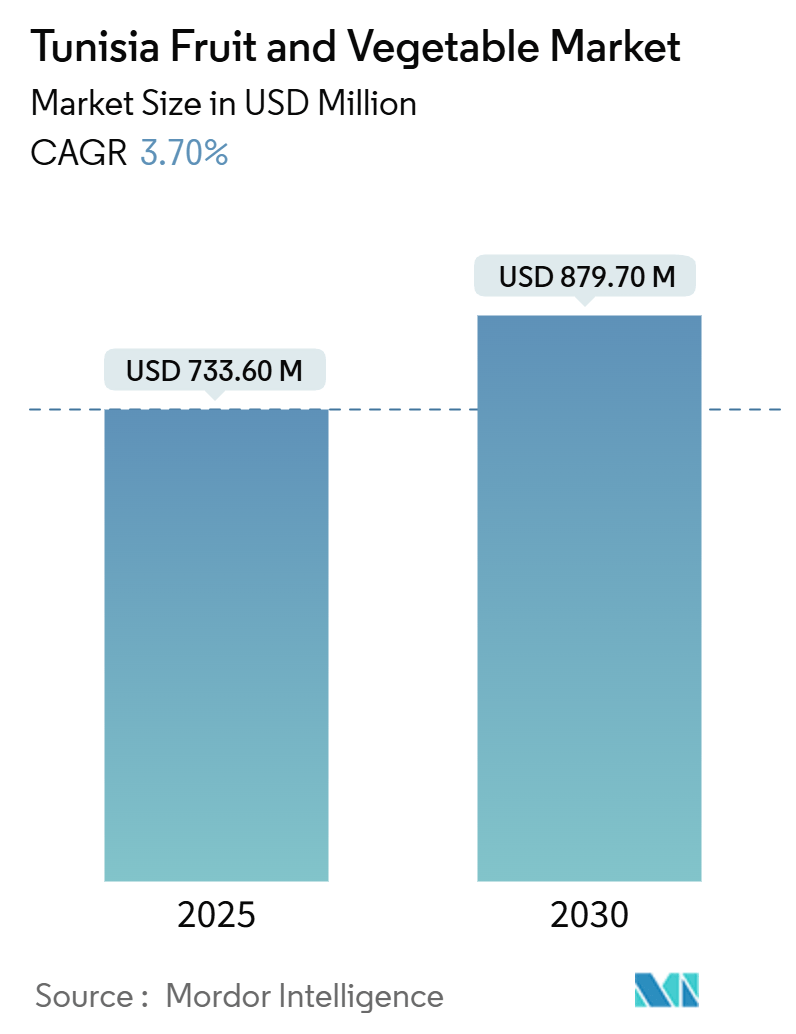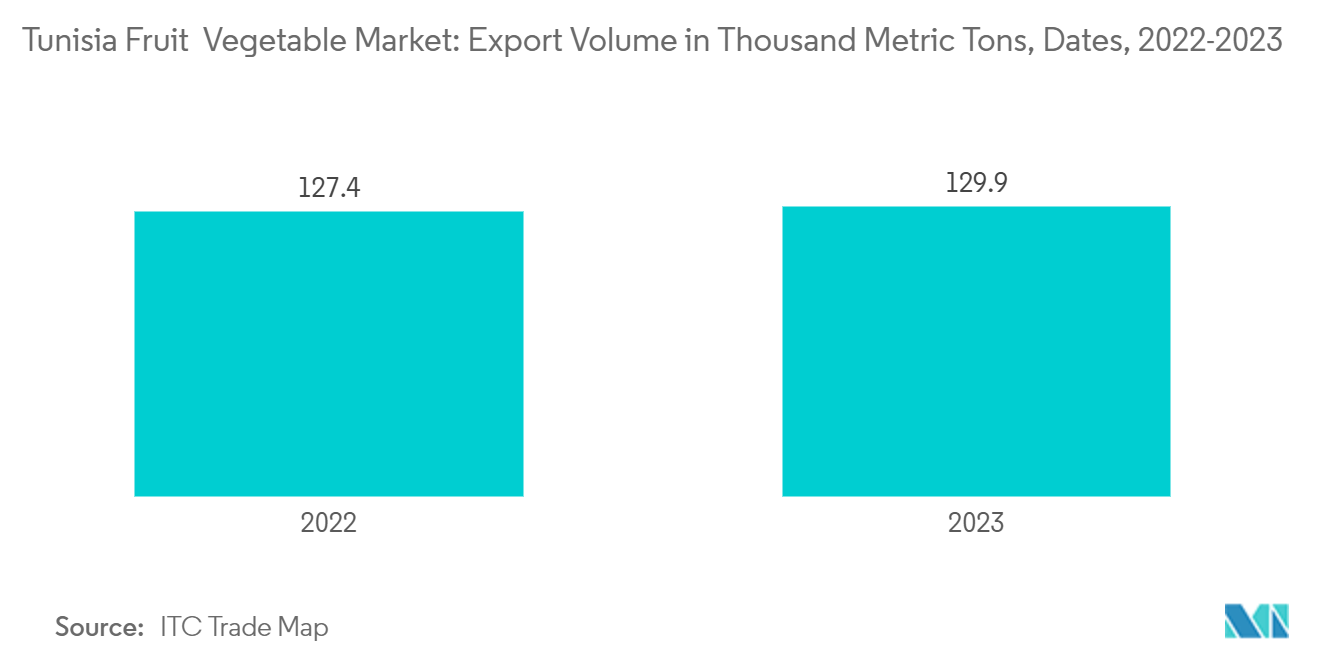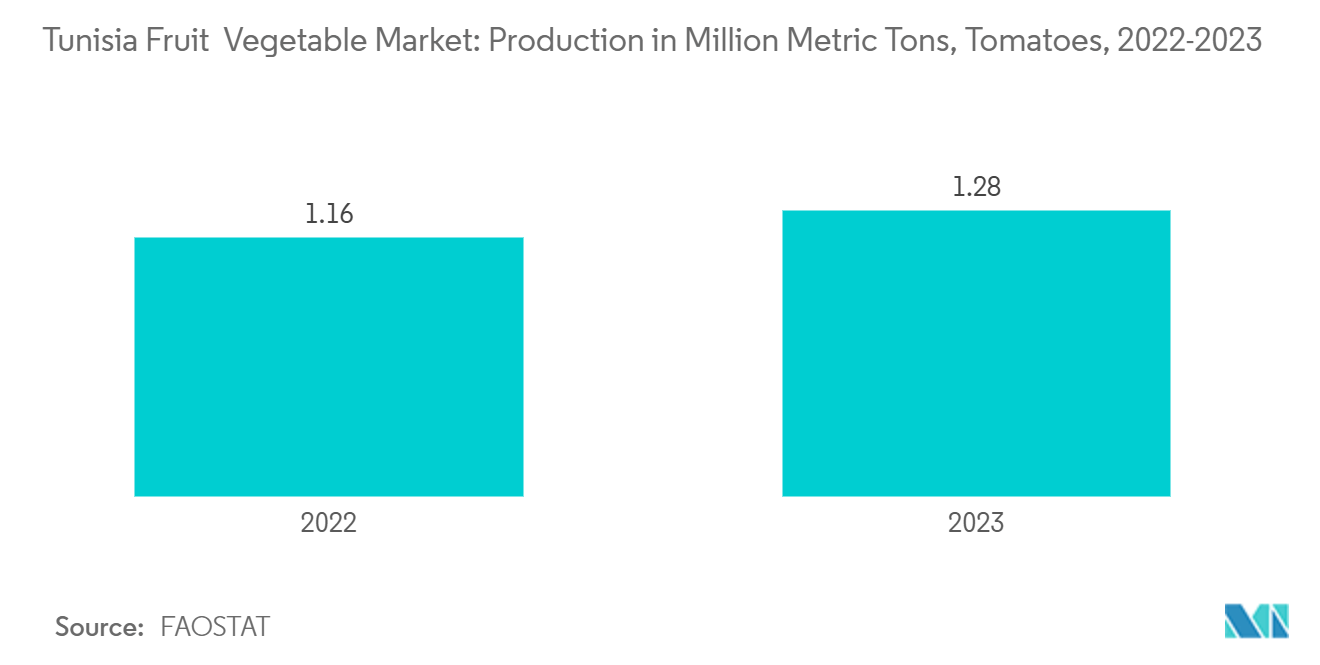
Tunisia Fruit And Vegetable Market Analysis by Mordor Intelligence
The Tunisia Fruit And Vegetable Market size is estimated at USD 733.60 million in 2025, and is expected to reach USD 879.70 million by 2030, at a CAGR of 3.70% during the forecast period (2025-2030).
The Tunisian fruit and vegetable market is expanding due to increasing consumer demand for affordable fruits like bananas, oranges, and naartjie, along with growing consumption of derived products such as fruit juices and jams. Rising consumer expenditure on fresh vegetables has further contributed to market growth. The fruit and vegetable market represents a strategic sector in Tunisia's economy. According to FAOSTATS data, vegetable production increased from 2.85 million metric tons in 2022 to 3.0 million metric tons in 2023. Fruit production also grew from 2.41 million metric tons in 2022 to 2.50 million metric tons in 2023. The World Bank reports that Tunisian agriculture contributed 9.47% to the country's GDP in 2023.
Tunisia has established itself as the second-largest exporter of organic products. According to the European Journal of Agriculture and Food Sciences in 2024, the country has 279,389 hectares of certified organic agriculture, representing 2.87% of its farmland. Research Institute of Organic Agriculture data indicates that 80.0% of Tunisian organic produce is exported. Tunisia holds a unique position as the only African country with organic agriculture equivalence recognition from both the EU and Switzerland. The country's proximity to European markets has significantly influenced its agricultural exports and driven organic farming growth to meet Europe's increasing demand for organic products.
Tunisia Fruit And Vegetable Market Trends and Insights
Rise in Export of Fruits and Vegetables
Tunisia's arid climate minimizes aflatoxin contamination in dried fruits, enhancing its position as a major regional exporter. The country's strategic location provides access to European, Middle Eastern, and North African (MENA) markets, serving as a gateway for other African countries. The fruit and vegetable market receives government support through minimum price guarantees, market liberalization policies, improved rural transport infrastructure, and investment incentives.
According to FAOSTATS, Tunisia's fruit-harvested area expanded from 252.1 million hectares in 2022 to 253.5 thousand hectares in 2023, increasing export capacity. ITC Trade Map data shows date exports increased from 127.4 thousand metric tons in 2022 to 129.9 thousand metric tons in 2023. Morocco, Libya, France, Italy, Germany, and Spain are the primary importers of Tunisian fruits, while Italy, France, the Netherlands, and Germany import most of Tunisia's vegetables.
Furthermore, the Tunisian government and international organizations have implemented agricultural development programs to enhance production and exports. In May 2023, Tunisia's Agri Ministry launched the Supporting Sustainable Agriculture and Fisheries program. This European-funded initiative, implemented by the Italian Development Cooperation Agency and World Food Programme, assists small-scale producers in managing production costs and climate change challenges. These measures strengthen food security and economic diversification, supporting market growth during the forecast period.

Vegetable Production Dominates the Market
Tunisia leads in the production of vegetables compared to fruits, which accounted for 3.0 million metric tons in 2023, showing a 5.26% increase from 2022, according to FAOSTATS. The harvested vegetable area expanded to 114.1 thousand hectares in 2023 from 111.9 thousand hectares in 2022.
The country's main vegetable crops include tomatoes, onions, chili, peppers, carrots, pumpkins, and cucumbers. Tomatoes and potatoes remain essential staples in Tunisian diets. FAOSTATS data shows tomato production increased to 1.28 million metric tons in 2023 from 1.16 million metric tons in 2022, while potato production grew to 0.43 million metric tons from 0.40 million metric tons. Market growth is supported by non-profit organizations and regional regulatory authorities promoting vegetable breeding, increased food consumption, and sustainable agricultural development.
Processing tomatoes holds a strategic position in Tunisia's agricultural development policy. The Ministry of Agriculture reports that over 10,000 farmers cultivated tomatoes across over 16,500 hectares as of 2022. The segment's growth is primarily driven by the increasing consumption of fresh tomatoes, which provide convenient and quick sources of nutrition. With vegetable production showing consistent growth in recent years, this upward trend is anticipated to continue through the forecast period.

Recent Industry Developments
- July 2024: The Food and Agriculture Organization launched a USD 500,000 emergency project in Tunisia to protect prickly pear through biological control methods, including the introduction of ladybugs as natural predators. Prickly pears, which cover approximately 600,000 hectares, serve as a significant income source for thousands of people, particularly women who harvest and sell the fruit.
- May 2023: The Tunisian Ministry of Agriculture launched the Supporting Sustainable Agriculture and Fisheries in Tunisia (ADAPT) initiative. The European Union funds this program, which the Italian Development Cooperation Agency implements in partnership with the World Food Programme. The initiative aims to support small-scale producers in Tunisia.
Tunisia Fruit And Vegetable Market Report Scope
Fruits and vegetables are important supplements to the human diet as they provide the essential nutrients for maintaining health. The Tunisian fruit and vegetable market is segmented by Type (Fruit and Vegetables). The report includes Production Analysis (volume), Consumption Analysis (value and volume), Import Analysis (value and volume), Export Analysis (value and volume), and Price Trend Analysis. The report offers market size and forecast in terms of value in USD and volume in metric tons for the above-mentioned segments.
| Vegetables |
| Fruits |
| Type (Production Analysis by Volume, Consumption Analysis by Volume and Value, Import Analysis by Volume and Value, Export Analysis by Volume and Value, and Price Trend Analysis) | Vegetables |
| Fruits |
Key Questions Answered in the Report
How big is the Tunisia Fruit And Vegetable Market?
The Tunisia Fruit And Vegetable Market size is expected to reach USD 733.60 million in 2025 and grow at a CAGR of 3.70% to reach USD 879.70 million by 2030.
What is the current Tunisia Fruit And Vegetable Market size?
In 2025, the Tunisia Fruit And Vegetable Market size is expected to reach USD 733.60 million.
What years does this Tunisia Fruit And Vegetable Market cover, and what was the market size in 2024?
In 2024, the Tunisia Fruit And Vegetable Market size was estimated at USD 706.46 million. The report covers the Tunisia Fruit And Vegetable Market historical market size for years: 2019, 2020, 2021, 2022, 2023 and 2024. The report also forecasts the Tunisia Fruit And Vegetable Market size for years: 2025, 2026, 2027, 2028, 2029 and 2030.
Page last updated on:
Tunisia Fruit And Vegetable Market Report
Statistics for the 2025 Tunisia Fruit And Vegetable market share, size and revenue growth rate, created by Mordor Intelligence™ Industry Reports. Tunisia Fruit And Vegetable analysis includes a market forecast outlook for 2025 to 2030 and historical overview. Get a sample of this industry analysis as a free report PDF download.

